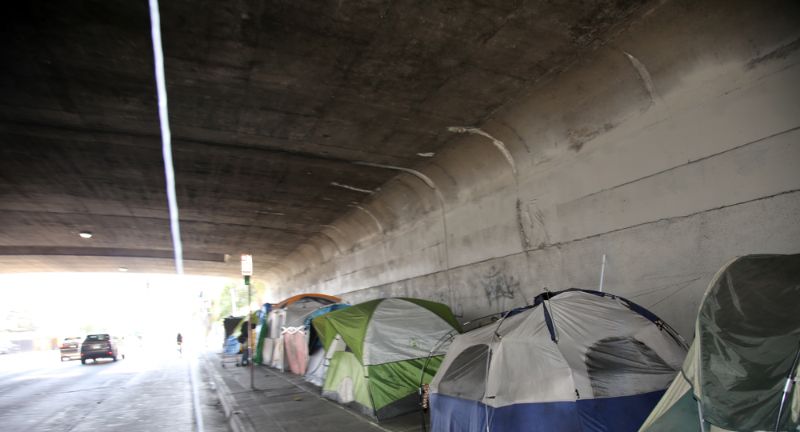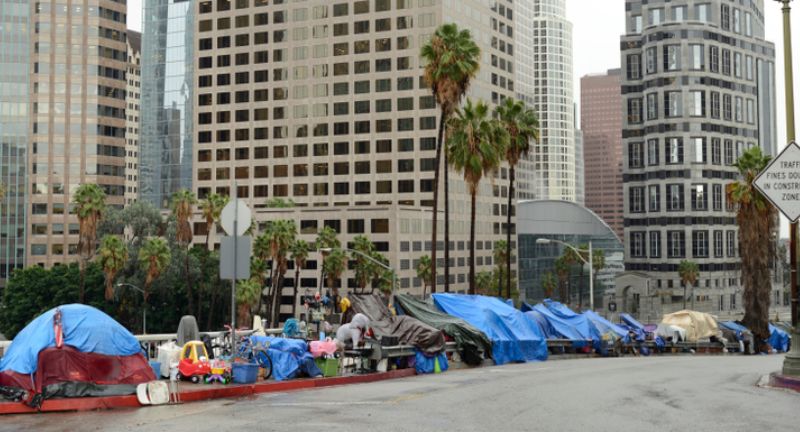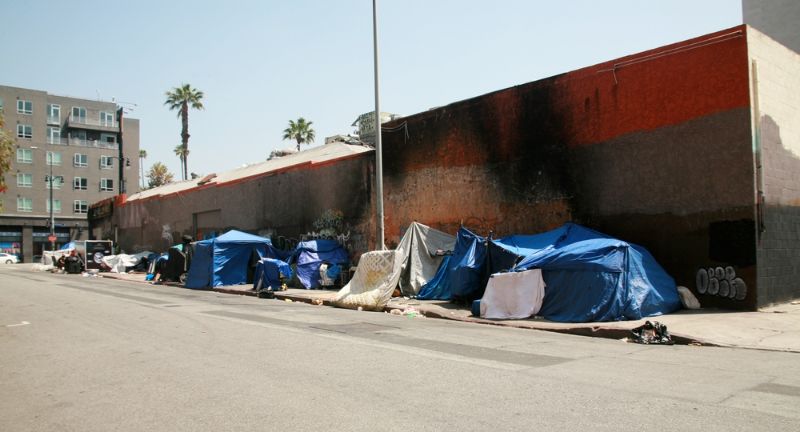NEWS
California’s Squatting Crisis Escalates, Drawing Critical National Attention
Published
9 months agoon

Shutterstock
California’s squatting crisis has reached a boiling point, drawing intense scrutiny from across the nation. As abandoned properties become makeshift homes, tensions rise between desperate squatters and frustrated property owners. Critics argue that the state’s housing policies have failed, exacerbating the situation to critical levels. With national eyes now on California, the pressure mounts for immediate and effective solutions to this growing crisis.
Innovative Housing Solutions

Shutterstock
To combat the squatting crisis, California has seen proposals for innovative housing solutions, such as converting vacant office buildings into residential units and developing modular homes. These solutions aim to increase the housing supply quickly and affordably. Pilot projects and zoning law reforms are underway in several cities, testing the feasibility of such approaches. If successful, these innovative strategies could provide a blueprint for rapidly expanding the state’s affordable housing inventory.
Public Perception and Stigma

Shutterstock
Squatting in California is frequently viewed negatively by the public, often linked with criminal behavior and social decline. This stigma can hinder initiatives aimed at tackling the underlying causes of squatting, including housing insecurity and homelessness. To overcome this stigma, public education campaigns are needed to shed light on the intricate socioeconomic factors driving the crisis and to share the personal stories of those impacted.
Legislative Reform

Shutterstock
California lawmakers are being encouraged to contemplate legislative reforms that address the squatting issue by balancing property rights and compassionate intervention. Suggestions include simplifying the eviction process for true cases of squatting, while maintaining robust protections against wrongful evictions. Further, there is a call for laws that promote the rehabilitation of vacant properties for use as affordable housing. Combining legislative reform with greater investment in affordable housing and social services is viewed as crucial for tackling the fundamental causes of the squatting problem.
Effects of Proposition 47 on Squatting

Shutterstock
The reclassification of nonviolent offenses under California’s Proposition 47 has had unintended repercussions on squatting activities. By reducing penalties for specific drug and property crimes, the law has made it more challenging for law enforcement to combat squatting. Critics argue that Proposition 47 has inadvertently encouraged squatting, as the perceived risks for breaking and entering or drug possession within squatted properties are now lower. Consequently, this has complicated efforts to address squatting and related criminal activities.
Tech Boom Displacement

Shutterstock
The growth of the tech industry in cities such as San Francisco and San Jose has caused displacement and a rise in squatting. As tech industry salaries drive up property values, many locals are forced out of their communities. This situation has led to an increase in squatting, as those displaced look for alternative housing options. While the tech boom has positively impacted the state’s economy, it has also unintentionally worsened housing insecurity for many.
Vacation Homes and Seasonal Squatting

Shutterstock
Vacation homes in tourist-heavy regions of California, including Lake Tahoe and coastal communities, face significant risks of squatting. These properties, frequently left unoccupied for extended periods throughout the year, become prime targets for unauthorized occupation. The issue of seasonal squatting underscores the importance of robust property management and security measures, especially in areas with a high concentration of vacation rentals.
Los Angeles’ Homeless Encampments

Shutterstock
In Los Angeles, the visibility of the homelessness crisis is most apparent through widespread encampments. These encampments often appear in public parks, underpasses, and vacant lots, reflecting the severity of the housing and homelessness crisis in the city. The challenge of providing adequate shelter and services to these populations has led to increased squatting in abandoned buildings and foreclosed homes. The situation underscores the need for comprehensive solutions that address both homelessness and housing affordability.
Legal and Policy Gridlock

Shutterstock
California’s legal framework and policy environment contribute to the squatting crisis. Tenant protection laws, while necessary for safeguarding renters, often make it difficult for property owners to reclaim their properties from squatters. The lengthy eviction process, compounded by a lack of clear policies targeting squatting, creates a legal and administrative quagmire. This has necessitated a balance between protecting tenant rights and addressing the squatting issue effectively.
Affordable Housing Shortfall

Shutterstock
California’s severe shortage of affordable housing is a major contributor to the squatting crisis. The state needs millions of new affordable housing units to address the existing demand, but this objective remains out of reach due to several regulatory and economic challenges. As a result, many individuals and families are left with no choice but to live in unstable conditions, such as squatting. Addressing this crisis requires a focus on significantly increasing the supply of affordable housing.
Impact of Nonprofits on California’s Squatting Crisis

Shutterstock
In California, nonprofit organizations are essential in tackling the squatting crisis. They deliver crucial services and advocate for the individuals affected. These nonprofits provide housing assistance, legal aid, and support services to facilitate the transition from squatting to stable living conditions. Collaboration between government agencies and nonprofit organizations is key to developing comprehensive solutions that address not only urgent needs but also long-term housing stability.
Environmental Hazards in Squatted Properties

Shutterstock
Squatted properties in California often encounter significant environmental health risks, such as exposure to mold, lead, and asbestos. These conditions present serious health dangers to the squatters and hinder efforts to restore these properties for legal use. Tackling the environmental health issues related to the squatting crisis is crucial for safeguarding the safety and well-being of all Californians.
Rural and Urban Squatting

Shutterstock
The squatting crisis in California affects both rural and urban regions, each presenting distinct challenges. In rural areas, squatters typically take over vacant land or agricultural properties, causing disputes over land use and property rights. In urban settings, particularly in cities with high housing costs, squatting usually involves occupying abandoned homes or commercial buildings. Effective solutions to squatting must account for the varied circumstances in which it arises.
The Connection Between Squatting and Mental Health Support in California

Shutterstock
In California, there is a critical concern regarding the link between squatting, mental health issues, and the lack of support services. Many individuals turn to squatting as a result of untreated mental health conditions, which are further exacerbated by the state’s overextended mental health services. It is essential to implement initiatives that expand access to mental health care and integrate support services with housing assistance. Addressing mental health needs is a vital part of any strategy aimed at reducing squatting and supporting the most vulnerable populations.
Influence of Squatting on Neighborhood Safety

Shutterstock
Squatting notably affects the safety and unity of communities in California. Properties occupied illegally can turn into centers for criminal activities, drug abuse, and poor sanitary conditions, which deteriorate the general well-being of the community. The existence of squatters in residential areas frequently sparks tension and worries among both homeowners and renters. Addressing the issue of squatting requires strategies that focus on preserving and improving the safety and quality of life in these neighborhoods.
Conclusion

Shutterstock
The squatting crisis in California encapsulates the broader challenges of housing insecurity, economic disparity, and social welfare facing the state today. Addressing this crisis requires a multifaceted approach that includes legislative reform, increased affordable housing development, and comprehensive support services for those in need. As stakeholders from various sectors collaborate towards innovative and humane solutions, there is hope for transforming this issue into an opportunity for strengthening community resilience and inclusivity. Ultimately, resolving the squatting crisis will not only alleviate immediate hardships but also lay the foundation for a more equitable and sustainable future in California.
More From Financially+
-


16 Signs Someone Is Way More Broke Than They Seem
-


12 Big US Cities That Act Like They’re the Center…
-


20 States Pushing for Higher Minimum Pay Amid Fierce Opposition
-


20 Electrifying Benefits of Switching to an Electric Car
-


20 Wild 1980’s Norms That Would Cause an Uproar Today
-


Stop Sabotaging Your Savings: 25 Bad Money Habits to Break…
-


20 Gems In The Midwest For An Ideal Retirement
-


26 Splurge Worthy Items That Are Truly Worth Every Penny
-


25 Sneaky Costs That Can Sabotage Your Savings
